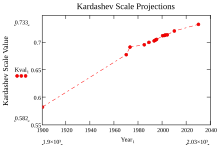Kardashov scale
The Kardaschow scale is a categorization proposed by the Russian astronomer Nikolai Kardaschow in 1964 for the level of development of extraterrestrial civilizations according to their energy consumption. Kardaschow had previously considered the energy consumption of radio links to hypothetical extraterrestrial civilizations.
The scale
In its basic form, the Kardaschow scale has three categories into which civilizations are classified based on their energy use.
- Type I: Civilization is at the technological level of today's (i.e. 1964) earth with a power requirement of 4 · 10 12 watts . This was later changed so that civilization would be able to use all of the power available on a planet . That is about 10 16 to 10 17 W. (For the earth this value is slightly larger than 1.74 · 10 17 W.)
- Type II: Civilization is able to use the full power of its central star. That is about 4 · 10 26 W.
- Type III: Civilization is able to use the full power of a galaxy . That is about 4 · 10 37 W.
A Type II civilization is thus roughly comparable to ten billion (10,000,000,000) Type I civilizations, a Type III civilization with a hundred billion (100,000,000,000) Type II civilizations. The exact ratios can vary by an order of magnitude or two, but it can be seen that the scale is exponential .
Various extensions to the scale have been suggested by other authors.
Remarks
Human civilization is currently well below Type I as it is only able to use part of the power available on Earth. In order to replace the consumption of limited fossil resources with a broader use of solar energy, human development needs to be taken. The current status of human civilization is called Type 0 . Although there were no intermediate values in Kardaschov's original proposal, Carl Sagan extrapolated the current human status to 0.7 using the following formula:
- ,
where K is the resulting civilization metric and P is the available power.
A hypothetical Type II civilization could build a Dyson Sphere or similar construct to harness all of a star's power.
A Type III civilization could use the same methods as a Type II civilization, but extended to all stars in a galaxy, or it could use previously unknown means.
criticism
It has been argued that we do not understand any advanced civilizations and therefore cannot predict their behavior. Therefore, the Kardashov scale may not be relevant or useful for the purpose of classifying extraterrestrial civilizations. This central argument can be found in the book Evolving the Alien: The Science of Extraterrestrial Life .
See also
Web links
- The Kardaschow Scale in the Internet Encyclopedia of Science
- Guillermo A. Lemarchand: Detectability of Extraterrestrial Technological Activities. (English)
- Marc G. Millis: Energy, incessant obsolescence, and the first interstellar missions @ arxiv.org; [1] Retrieved January 24, 2012
- What Kardashev Really Said centauri-dreams.org, accessed March 25, 2014
- How to find extraterrestrial civilizations - the Kardaschow scale on YouTube by Kurzgesagt - In a Nutshell
Individual evidence
- ^ NS Kardashev: Transmission of Information by Extraterrestrial Civilizations . In: Sovjet Astronomy AJ . Vol. 25, No. 2 , 1964, p. 217 , bibcode : 1964SvA ..... 8..217K .
- ^ RA Carrigan Jr .: Starry Messages: Searching for Signatures of Interstellar Archeology . In: J. Br. Interplanet. Soc. Vol. 63, 2010, pp. 90-103 , arxiv : 1001.5455v1 .
- ^ Jack Cohen and Ian Stewart: Evolving the Alien: The Science of Extraterrestrial Life , Ebury Press, 2002, ISBN 0-09-187927-2


